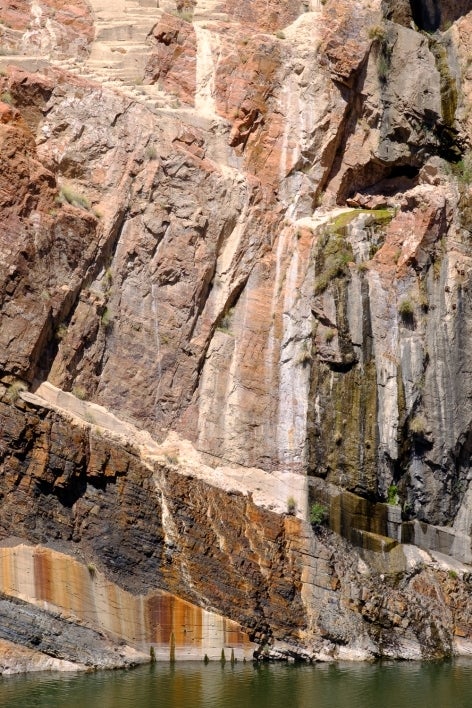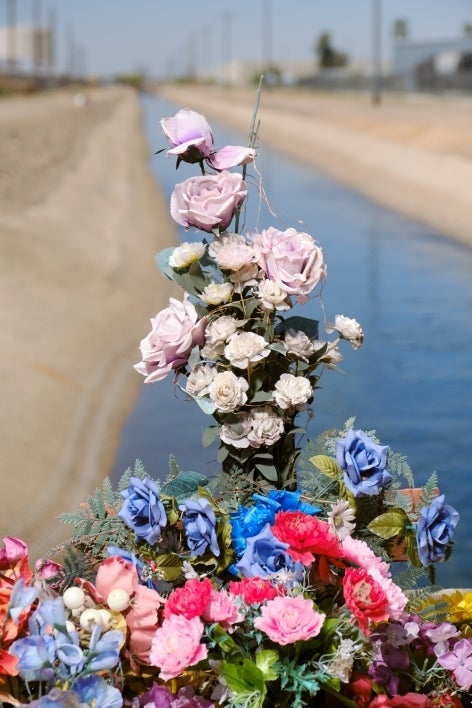The hidden structure of the Arizona oasis

An open page from the Sonoran Water craft book. Courtesy of David Blakeman.
The Phoenix metro area is teeming with life going in and out of air-conditioned buildings, up and down paved roads and around a city that goes on for miles with lights when one flies over. Standing on the ground, it can be difficult to imagine the surrounding expanse of desert.
Associate Professor of religious studies Jason Bruner and local photographer David Blakeman wanted to explore questions about place, change and temporality in the desert beginning in fall 2019. They pitched the project of a craft book called "Sonoran Water" that would incorporate photography and creative writing to the Institute for Humanities Research’s Desert Humanities Initiative.
“This infrastructure — the canals, dams, concrete, air conditioning and so on — have insulated us from the desert and they come at an enormous cost,” Bruner said. “That cost is environmental, but it’s also financial and, I dare say, spiritual. Spiritual in the sense that it does something to how we understand our relationship to others and to the land.”
They officially began the project in January 2020 when they would meet and ride up and down the canals in Tempe, Scottsdale and Phoenix with their notebooks and cameras.
“We would go through David’s photos, talk about our reactions, the ones we thought were capturing a sense of what we wanted the project to look and feel like,” Bruner said. “For the essay that weaves through the book, I was reading a wide range of material, from SRP pamphlets and brochures, to local histories, Bureau of Land Management information, local crime reports and histories of the American West.”
Some of the trips they took were short and preplanned, while others were day trips to various locations in Arizona, such as Saguaro Lake, the Salt River or Roosevelt Lake. When the pandemic hit, they began working separately for most of the project, but kept in touch to discuss their ideas.
Blakeman’s photos helped guide the tone of the essay written by Bruner for the book, which he finished writing in early summer.
“This project is the creative output of two people who, like many Arizonans, feel deeply grateful for the technological marvels that have made life possible here but also deeply conflicted about the sustainability of this wonderful, death-defying feat of urban planning,” Blakeman said.
Both Bruner and Blakeman are grateful for the opportunity to complete the project, the first in the Desert Humanities series. Bruner said the project was the most enjoyable project he’s worked on in his seven years at Arizona State University.
“I hope this is a small contribution towards a different imagination of this place,” Bruner said. “I also think this project, and the larger craft book series that the Desert Humanities Initiative is producing, is valuable as a space in which scholars and artists can try something different. I wanted to pursue a project that challenged me in new ways, both in terms of how I worked and in terms of style.”
They extend their thanks to Institute for Humanities Research Director Ron Broglio and to Tyler Owens, who designed the layout, for helping make the project a reality.
Some photos from the book can be viewed on Blakeman’s website and more information about the project is available through the IHR.
More Environment and sustainability

Researcher works on changing people's mindsets to fight climate change
Meaningful action to heal the climate requires a complete shift in the way people think and perceive each other, according to an…

NOAA, ASU offer workshop to bridge ocean exploration, education
Oceans are vital to sustaining life on Earth, as they produce over half of the oxygen we breathe and play a crucial role in…

A united front for sustainability and the economy
When four leaders of esteemed learning institutions and the mayor of Phoenix gather in one location at the same time, it’s a tip-…



